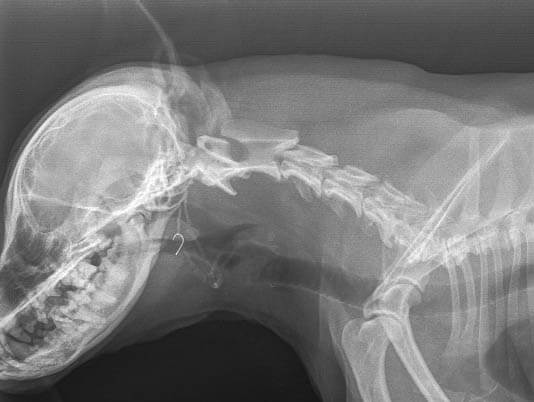On Bonfire Night last year, the Knutsford Veterinary Surgery Team were on a staff night out to watch the fireworks at Boothes Hall when they got a panicked emergency call. Whiz, a 14 year old Jack Russell, was on a walk around the nearby fishing lake and came across a discarded fishing line (with bait) which was promptly ingested! Amazingly, this was not the first time Whiz had eaten fishhooks, but it did mean her owners knew what to do.
She was brought down to the surgery where despite a good oral examination, the hook and fishing line were nowhere to be seen. “Fish hooks can be a real problem,” Paul from Knutsford Vets advises. “They can perforate the stomach or intestines and if they have a fishing line attached can even cheese-wire through the guts, so prompt action is always advised.”
State of the art vets in Cheshire
Metallic objects such as fishhooks show up well on x-ray and help identify if they are stuck in the mouth, bottom, or anywhere in-between. Whiz was given a brief sedation and x-rays revealed that she had not one, but two fish hooks inside her. The first was lodged at the back of her throat and using some long forceps was unhooked and successfully removed. The second was in her rectum and had obviously been ingested days, or even weeks, prior and had luckily worked its way through. This too was successfully located and removed.
Incidentally, on x-ray it was noted that Whiz had a large mass in her abdomen, near her spleen and liver. An in-house ultrasound scan confirmed that the mass was 7cm in size, originating from the spleen which is a very vascular organ. It contained large cysts of blood that looked like they might rupture at any time and if so, it would have been fatal. Luckily the rest of her organs appeared unaffected, including her heart, which is where malignant splenic tumours usually spread to.
Quick, caring and decisive care
Whiz was rushed through to theatre where the tumour was removed just in time, as the mass had started to bleed from two small areas. The rest of her organs were examined to ensure there had been no damage caused by the passage of the second fishhook. After an overnight stay, she was very bright and ready to go home for lots of TLC.
Whiz’s owner tells us “We feared the worse. We had been told to prepare for the fact the tumour could be malignant and may have already spread elsewhere in the body.” Thankfully for whiz, after an agonising week of waiting, the laboratory confirmed that the tumour was benign and removal curative. “Her recovery was uneventful and she is like a puppy again with no further treatment required. We cannot thank Paul enough.”





